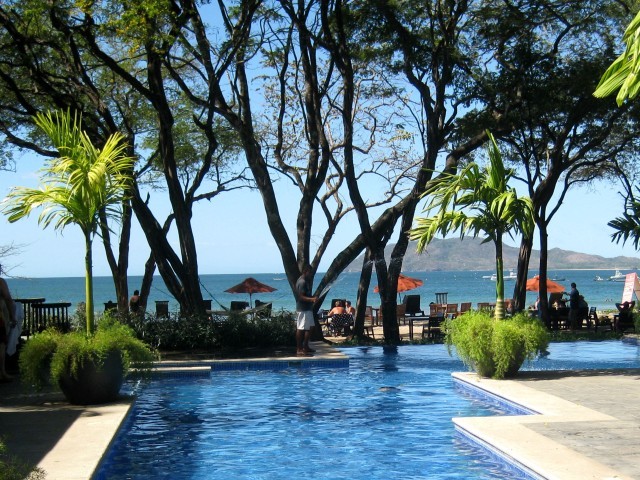You’ve probably seen articles by single backpackers about how to travel the world for $500 a month.
Sure, it’s possible, if you stay in dorms or hostels in Thailand and live on street food. In fact, it can be a great experience, but it’s not right for everyone.
If you’re a family like us, or you just want to travel with a little more luxury, is it still possible to afford to travel for months at a time?
It is possible. In fact, you can take a career break and travel for a couple of months for less than the cost of a typical vacation. I’ll explain how we do it.
Charles and I are always asked how we can afford to travel for months at a time, especially with two little kids. As a family, we’ve traveled for months through Mexico, Costa Rica, the US, Asia and the Philippines. Trust me, we’re not lottery winners, or independently wealthy. We have to to work for it, just like everyone else.
We’ve learned some great tricks that might just help you take that dream long vacation. Stay with me, and I’ll explain how we do it.
A traditional vacation is insanely expensive
Because most people take their vacations at peak times like Spring Break or Christmas, they pay top prices for everything: food, hotels, airfare, tours and attraction tickets. Peak prices are almost always two to four times more than off peak rates!
On top of that, because they’re understandably trying to compress all of their fun into a short time, they end up paying for conveniences like restaurant meals and expensive tours, when they could do the same thing for a fraction of the price if they had the time.
We’ve all been there (us included), trying to schedule a vacation during time off from work, and stuck with crazy high season prices. There’s a better way.
Avoid the crowds and cut costs
By traveling off peak or shoulder season, you’ll cut your prices significantly. We just splurged for a night at the four star Delta Sun Peaks Resort in British Columbia, Canada for $102 during their shoulder season. The resort’s regular season rate is $189.00. Not only are prices lower during non-peak season, but it’s much easier to negotiate travel deals and added perks.
Save money by renting for longer
The savings add up. Not only can you reduce your rate by going during non-peak times, but you can lower it even further by renting for a longer period. This sounds counter-intuitive, but stay with me.
When you travel for a month or more, you can get a monthly rate on a vacation home or condo. As a rule of thumb, we find that monthly rates are about equal to what the owners ask for two weeks. This strategy works best with individual owners (rather than property management companies). Most owners are delighted to have their place rented out for a month. It’s much less hassle than having to deal with renting their condo out to different people, often just for a few days at a time. Plus, they’re guaranteed a certain amount of money for the month.
During our last stay in the Playa del Carmen, Mexico, we rented a gorgeous two bedroom condo, everything included, with a nice pool and a four minute walk to the beach, for $1,200 per month. If we’d been prepared to stay longer in the Mayan Riviera, we were quoted rates as low as $900 per month (for staying up to four months) for something similar. If we’d been staying truly off season (in the summer) we probably could have reduced the rate by a couple of hundred dollars more per month. We stayed for a month at the clean and modern Mango Condos in Tamarindo Costa Rica, for $1,200 as well.
Once you stay at a place more than a month, you can start to negotiate local rates. Landlords start to think of you more as renters than tourists, and prices go way down. The longer you stay, the cheaper your rent becomes.
Find a few condos you like through Airbnb (my new favorite for the lowest prices), HomeAway or TripAdvisor, and email the owners asking for their best monthly rate. When they email you back, ask for a further discount. Always be polite, and say that your budget only allows for a certain amount. This goes a long way towards getting someone to help you.
Looking for a great deal on your next Airbnb? Follow our link to get a $35 credit! (And we get a credit, too).
You can slash your accommodation costs completely by using a home swap service. This site lets you swap a stay in your home for a stay almost anywhere in the world. Because we’ve rented for the past few years, we’ve never done a home swap, but we’ll definitely give it a try when we own again.
House sitting or volunteering (some volunteer positions provide accommodation) may be a way to reduce your costs even more.
Shop like the locals
Because you can self-cater, you’ll pay much less than eating at restaurants for every meal. On top of this, in tropical destinations, fruits and veggies are a fraction of the price at local markets than at your supermarket at home.
Try to shop like the locals, and you’ll save a lot of money. In many countries, including Mexico and Costa Rica, locals buy most of their fresh food at outdoor markets for much less than at large chain supermarkets. We’ve found that we pay almost the same price all over the world for typical, packaged convenience foods in supermarkets however some countries sell staples like dairy or chicken for much less than at home.
When you’re somewhere for a month or more, you have time to scout the local restaurants, and ask the locals the best places to eat. Not only can this save you a fortune, but you can find some of the best local hangouts. Our two month stay gave us time to find some of the most affordable restaurants in Playa del Carmen. While you will be eating more because you’re staying longer, you’d be eating at home anyway, so there’s no real additional cost.
When you stay for a longer time, you have more time to explore the area, cutting down on costs for entertainment and tours. For example, a $85 whirlwind guided cenote and snorkeling tour in Mexico’s Yucatan can become a leisurely two or three day affair, costing a tenth of the price simply using existing transit.
Flexible travel times = cheaper flights
You can also save on airfare for a long vacation. During your typical one week holiday, travel dates are usually very constrained, because you want to get as many days at your destination as possible. With a longer stay, you have enough time to move your dates a few days in either direction. Having a little flexibility in your dates can save you a lot of money. In general, traveling mid-week (especially Tuesday through Thursday) is much cheaper than traveling on the weekend. On top of this, airfares are much cheaper during non-peak times, saving you more.
Our favorite airfare search tool is Skyscanner. Skyscanner will let you search a calendar of fares for up to one month, and give you results for airports near your destination and departure cities. Like any search engine, there are some smaller discount airlines (like Allegiant air) that aren’t included in their searches, so be sure to check discount airlines as well.
Click here to search Skyscanner.
Need some more inspiration? Check out 30Traveler’s list of apartment rentals you can score for $400 a week around the world.
What about getting time off work, taking the kids out of school, or being able to save enough money?
These are great questions, and I’ll tackle them in detail in our next posts. Depending on your situation, dealing with these may be easier than you think.
If you’re a little further along in the planning process, check out what we do with our stuff when we travel.
Have you ever wanted to take an extended career break? If you had a few months off, where would you go?







